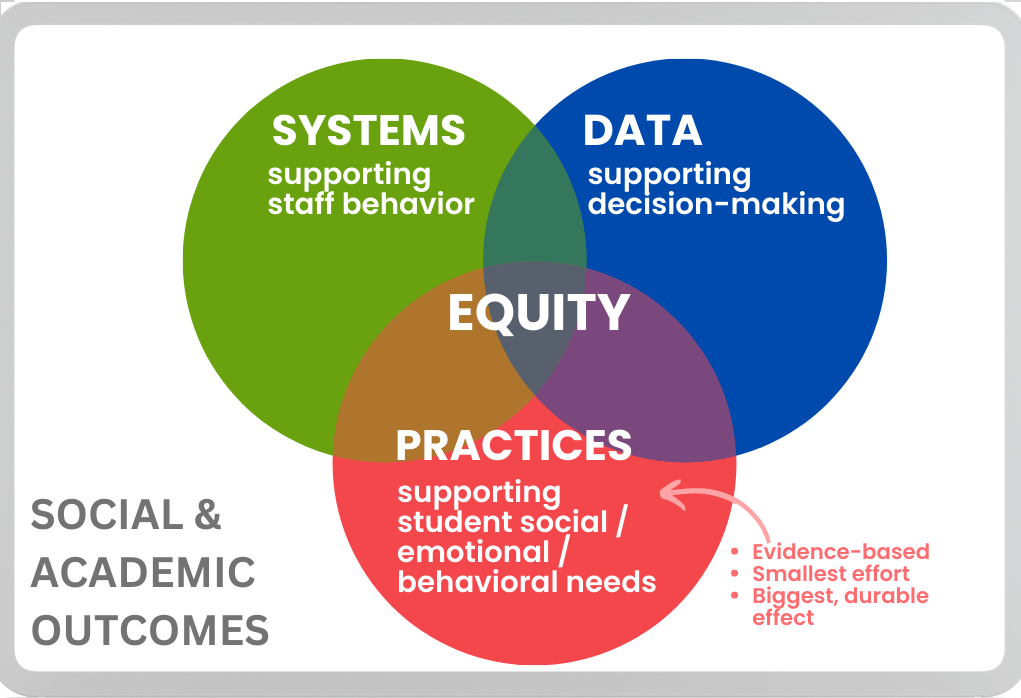WHAT IS PBIS?
Positive Behavioral Interventions and Supports (PBIS) is an evidence-based, culturally responsive, Multi-Tiered System of Supports (MTSS) framework for developing and maintaining proactive, effective, and equitable learning environments where all students are successful. It is a commitment to addressing students’ social/emotional/behavioral needs through systems change, evidence-based practices, and data-based decision-making. When PBIS is implemented with fidelity, students achieve improved social and academic outcomes, schools experience reduced exclusionary discipline practices, and school personnel feel more effective.

At the Universal level, preventative and proactive strategies support all students and staff. During the Universal PBIS Training, school leadership teams develop an implementation plan and Staff Handbook based on the following components:
- Statement of Purpose
- Define Expectations/Agreements (3-4)
- Teach and practice prosocial behaviors
- Acknowledge and provide feedback on prosocial behaviors
- Prevent and respond instructionally to interfering behaviors through a continuum of supports
- Make decisions based on data
Steps to Implementation:
Thank you for your interest in PBIS! Please use the VTPBIS Universal Level Readiness Checklist to track completion of training and implementation readiness steps. Submit the completed checklist to Anne Dubie at [email protected] at least two weeks prior to training. If you have any questions, contact the VTPBIS State Technical Assistance Provider (TA) for your SD/SU.
STEP 1: Learn More
- Identify an exploration team, including an SD/SU point of contact, building principal and other representative school personnel.
- All exploration/leadership team members complete the Intro to PBIS Microlearning videos and review/discuss activities. This will take 45-60 minutes. Certificate of attendance for documentation of professional development is available upon request.
- Optional:
- Attend VTPBIS Annual Forum (October)
- Talk with other schools implementing PBIS (Click HERE to locate a school near you)
STEP 2: Get Started
- Administrator: Contact the VTPBIS State Technical Assistance Provider (TA) for your SD/SU to indicate your team’s interest in being trained. Your TA will help you complete the following steps.
- Schedule and provide a PBIS Awareness/Input workshop for all school staff. This will be facilitated by your TA. The workshop will include foundational information about PBIS, offer an opportunity to gather staff input about social/emotional/behavioral needs, and explore the “compelling why” for implementing PBIS at your school.
- Invite all staff members to vote on whether or not to move forward with PBIS implementation. When you have achieved 80% approval rate, continue to Step 3.
STEP 3: Complete Readiness Activities
- Submit VTPBIS Intent to Implement Application. Due January 1st for Spring training and April 1st for June training.
- Identify PBIS leadership team members to attend Universal Training either in the Spring or at the BEST/VTmtss Summer Institute in June. PBIS team members participating in the training should include the administrator, PBIS coordinator, staff member with applied behavior expertise, other representative staff members and, if possible, student and/or family/caregiver representative(s).
- Register and pay for your team to attend Universal Training.
- School and SD/SU PBIS coordinators participate in a Pre-Training Coordinator Orientation Meeting.
- Administrator or coordinator: Consider contacting the SD/SU grants manager to request BEST/Act 230 (or local) funds for implementation coaching and professional development for the upcoming school year. It is important to share this need with the grants coordinator well in advance of the grant submission deadline (typically end of June).
STEP 4: Collect and Review Data to Use During Universal Training (your TA will guide you through this process)
- Complete processes for gathering data about social/emotional/behavioral needs from students and family/caregivers as outlined in the VTPBIS First Steps to Implementation online module series.
- As a team, review data gathered from staff, students, and family/caregivers about social/emotional/behavioral needs. Identify 3-4 potential school-wide expectations/agreements that address these needs. Share and collect feedback about the potential school-wide expectations from staff, students, and caregivers/parents/guardians.
- Complete baseline PBIS Assessments:
- Provide time during staff and support staff meetings to facilitate all staff in completing the online Self-Assessment Survey (SAS). You will receive instructions for completing this survey after we receive your Intent to Implement Application.
- TA conducts baseline fidelity assessment with PBIS Leadership team.
- If your school has school climate data available, ensure that it is accessible for your team to use during Universal training.
- Submit VTPBIS Universal Level Readiness Checklist to Anne Dubie at [email protected].
STEP 5: Universal Training and Implementation
- Attend Universal Leadership Team Training (Spring or BEST/VTmtss Summer Institute).
- Arrange for first-year implementation coaching.
- Attend additional professional development (see VTPBIS Professional Learning calendar)
- Navigating SWIS webinar (September)
- VTPBIS Coordinators’ Welcome Back webinar (September)
- VTPBIS Annual Forum (October)
- Data Days (in-person or webinar) (Fall)
- Coordinators’ Learning and Networking meetings (January & May)
- Other PD opportunities as pertinent
